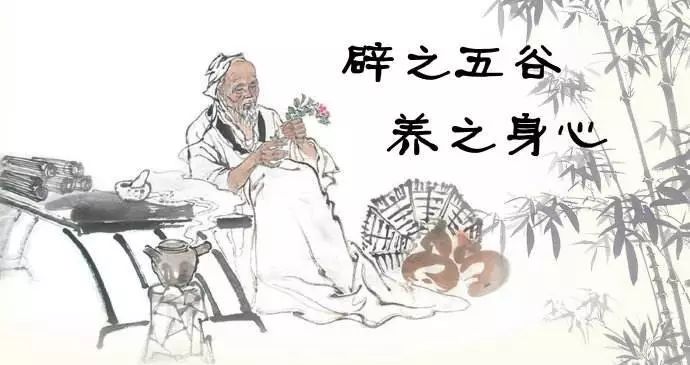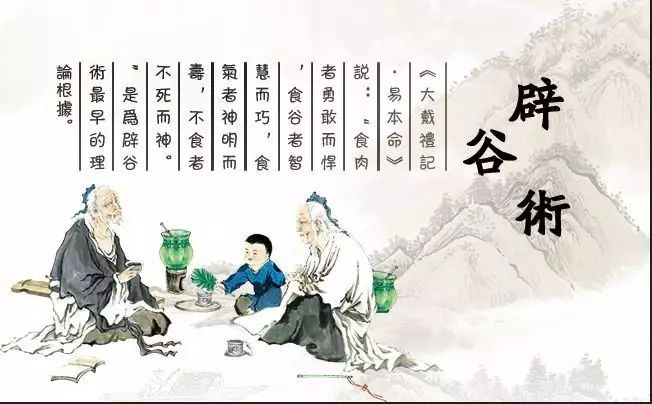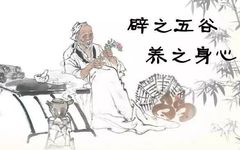
Fasting (Bigu)
refers to a method of inducing the body’s potential and innate qualities through a series of practices such as breath control (shiqi), swallowing saliva, and guidance techniques, without any “nutritional substances” provided. This method aims to help the body obtain energy, eliminate accumulated fats, toxins, and waste, thus entering a new balanced state. It is an ecological natural therapy aimed at health preservation and disease prevention, comprising a comprehensive and systematic set of guidance and breathing techniques.
Author: Liu Changxi, Beijing University of Chinese Medicine
Fasting is a traditional Chinese health preservation and longevity method with a history of thousands of years. The term “Bigu” means to avoid or escape from food (grains). It is a comprehensive, systematic set of guidance and breathing techniques that falls under the category of TCM Qigong.
Both the Huangdi Neijing (Yellow Emperor’s Inner Canon) and Shanghan Lun (Treatise on Cold Damage) record methods of using dietary control to treat diseases. Similar practices are found in various religions and cultures, such as the fasting during Ramadan in Islam, Yom Kippur in Judaism, and the Buddhist advocacy for vegetarianism and abstaining from food after noon. Particularly in recent years, fasting and Calorie Restriction (CR) therapies have gained popularity in the international community, supported by numerous clinical and experimental studies that confirm their effectiveness in extending lifespan and preventing various chronic diseases, making them a low-cost and low-risk option for managing chronic non-communicable diseases. Fasting has unique advantages compared to other fasting and energy restriction therapies.
The Origin of Fasting in China
The original intention of fasting was not primarily for health preservation but rather to “avoid famine” and “seek survival.” It gradually evolved into a superior method of “immortal cultivation” after being adopted by Daoism. Practitioners believed that the human body contains the “Three Corpses” (san shi), which are harmful to the body, and that by practicing fasting, one could eliminate these entities and achieve immortality.

Fasting was first advocated by pre-Qin scholars and later promoted by Daoism, while also being applied by Confucianism, Buddhism, and medical practitioners. The earliest literature on fasting can be traced back to around 200 BC during the Western Han Dynasty. The “Que Gu Shi Qi Pian” (Treatise on Fasting) unearthed from the Mawangdui tomb in 1973 is the first monograph on fasting in China. This brief article of over 300 words showcases the cultivation practices from over two thousand years ago and indicates that the method of fasting was already widely known and had influenced the emperors in the deep palace. Subsequent historical texts from various periods in ancient China also record instances of fasting. For example, Shiji (Records of the Grand Historian) mentions Zhang Liang of the Western Han using guidance techniques for fasting, while Records of the Three Kingdoms documents Cao Zhi observing Qie Jian’s fasting practices. Numerous ancient texts such as Liang Shu, Wei Shu, Sui Shu, Bei Shi, and Song Shi also record examples of fasting.
From these historical records of fasting practices, we can see the recognition and admiration of fasting, especially among the nobility. Zhang Liang of the Western Han is recorded as the earliest pioneer of fasting and the first to prove its efficacy in treating diseases. Sima Qian noted in Shiji: The Family of Liu that “Zhang Liang was often ill and practiced guidance without eating grains.” Ge Hong of the Jin Dynasty recorded in Baopuzi: The Ultimate Principle that “Zhang Liang practiced guidance and abstained from grains for a year, achieving a light and agile state.”
Fasting not only has historical traces but also has its theoretical connotations and technical methods detailed in the writings of practitioners throughout the ages. Sima Chengzhen of the Tang Dynasty wrote in Fuqi Jingyi Lun: “Those who eat grains are wise but short-lived; those who eat air are spiritual and long-lived; those who do not eat do not die… Inhale air to condense essence, preserve energy to refine form. When essence is full and spirit is complete, form rests and life is prolonged.” Sima emphasized that “regulating body, breath, and spirit” is the core of fasting practice. The Shen Qi Yang Xing Lun states that the key to fasting is to gather spirit and refine energy, empty the mind, relax the body, and practice abdominal breathing. Qi (气), air; 氣, the energy of food; 炁, the innate energy. The Shen Qi Yang Xing Lun states: “Among all beings between heaven and earth, humans are the most spiritual, and the only elements that can nourish the human form are Qi and spirit… Knowing that spirit and Qi can preserve form, one should guard emptiness to nourish spirit and Qi, and knowing that the void can lead to truth, one should enter the void to observe the essence, thus between heaven and earth, it is like a bellows!” This highlights the key of abdominal breathing in fasting practice. Additionally, texts such as Tai Xi Jing Wei Lun, Huang Ting Jing, Baopuzi Biezhi, Cun Shen Lian Qi Ming, Zhen Qi Huan Yuan Ming, Gao Shang Yu Huang Tai Xi Jing, You Zhen Xiansheng Fu Nei Yuan Qi Jue, Yan Ling Xiansheng Ji Xin Jiu Fu Qi Jing, and Tai Qing Tiao Qi Jing describe various methods of fasting and guidance from different perspectives. Ge Hong, Tao Hongjing of the Song Dynasty, and Sun Simiao of the Tang Dynasty are all theorists and practitioners of fasting.
Correct Understanding and Definition of Fasting Must Be Based on Authentic Sources
According to the Bo Wu Zhi, the methods of guidance in fasting originated from ancient people’s imitation of the postures and breathing of animals such as snakes, turtles, and toads. After practicing guidance for a period, one can reach a state of “full Qi and no desire for food,” naturally proceeding with fasting, also known as breath fasting. This is the original and most traditional form of fasting.

With the advancement of medical technology and society, a method of fasting that involves consuming specially prepared food or medicinal substances has emerged, known as food fasting. It is clear that the commonality between these two forms of fasting is based on breath control (shiqi), swallowing saliva, and guidance techniques. Therefore, fasting refers to a method of inducing the body’s potential and innate qualities through a series of practices such as breath control (shiqi), swallowing saliva, and guidance techniques, or/and consuming food (food or medicinal substances), without any “nutritional substances” provided, to help the body obtain energy, eliminate accumulated fats, toxins, and waste, thus entering a new balanced state, achieving health preservation and longevity through ecological natural therapy, comprising a comprehensive and systematic set of guidance and breathing techniques.
The fundamental connotation of fasting includes guidance (or/and food consumption) and abstinence. Guidance techniques are the core technology in the fasting process. Guidance, also known as “Dao Yin,” is first mentioned in the pre-Qin text Zhuangzi: Ke Yi: “Blowing and breathing, exhaling the old and inhaling the new, is the way to longevity.” The Tang Dynasty commentator Cheng Xuanying explained: “Guiding spirit and Qi to nourish the body and soul is the way to extend life and preserve form.” Jin Dynasty commentator Li Yi noted: “Guiding Qi to harmonize and leading the body to soften.” The Tai Chi Chuan Pu: Thirteen Postures states: “Using the mind to move Qi, ensuring calmness, one can gather it into the bones, using Qi to move the body, ensuring smoothness, one can facilitate the heart’s intentions.” Wang Zongyue’s Tai Chi Chuan Lun: Thirteen Postures Song states: “Qi circulates throughout the body without stagnation… the abdomen is relaxed, and Qi rises.” This views guidance as a method of moving Qi and body movements, a conscious guidance of breath that promotes the body’s movements in bending, stretching, spiraling, responding to movement and stillness, balancing hardness and softness, and harmonizing Yin and Yang. The “Zhu Bing Yuan Hou Lun”, compiled by the state-appointed physician Chao Yuanfang during the Sui Dynasty, included 287 guidance methods, officially marking the application of guidance techniques in clinical practice. Before fasting, one should practice “breath guidance” until reaching the state of “full Qi and no desire for food, full spirit and no desire for sleep” to avoid hunger and weakness caused by fasting, while enhancing energy, joy, lightness, and agility. The Da Dai Li Ji: Yi Ben Ming states: “Those who eat meat are brave and fierce; those who eat grains are wise and skillful; those who eat air are spiritual and long-lived; those who do not eat do not die and are divine.” This is the earliest theoretical basis for fasting. Later generations greatly emphasized the study of fasting guidance methods, leading to the emergence of numerous fasting guidance and food consumption methods, promoting the development and application of fasting.
Secondly, abstinence is a fundamental requirement of fasting. Achieving a fasting state without hunger, weakness, or discomfort, while feeling joyful, is the standard state of fasting based on guidance or/and food consumption.
Fasting Should Be Practiced Under Professional Guidance
Based on years of research experience and data collection, the author summarizes scientific fasting into five essential elements: breath control, walking while reciting, jade toad wave, systematic methods, and scientific theory. Fasting does not involve grains but can maintain normal bodily functions and has extraordinary effects, primarily due to the practice of breath guidance. Breath control, also known as “shiqi,” “xingqi,” “guidance,” or “tuna,” is a practice that utilizes all channels of the human body to exchange information and energy with the external environment, thus obtaining elements that sustain life vitality. Although breath guidance and fasting often appear in the same practice form, they are fundamentally different. Many ancient texts document breath guidance methods, and many people continue to study and practice them today.

Anyone practicing fasting must not practice recklessly; they must follow the methods of breath guidance. This is not a simple process of breathing in air but involves the complex life phenomena of the human body, concerning the energy exchange and information communication between the microcosm of the human body and the macrocosm of nature. It regulates the internal Qi of the body and absorbs the “pure Qi” from the natural universe to replenish the body’s elements and other subtle substances.
Based on the study of ancient texts related to fasting from Confucianism, Buddhism, Daoism, and medicine, the author has summarized a comprehensive, systematic, and scientifically effective method of fasting through years of dedicated research and personal practice, visiting numerous experts both domestically and internationally, and integrating modern medicine, nutrition, and rehabilitation theories and methods.
This set of practices includes both dynamic and static exercises. Dynamic exercises include morning routines before getting out of bed (the second section of the jade toad wave for all four limbs, and the third section for abdominal extension), Daoist circular exercises (circular movements of all joints from neck, shoulders, elbows, wrists, palms, fingers, to waist, hips, knees, ankles, and toes), fasting exercises (morning, noon, and evening fasting exercises centered on the jade toad wave, divided into three sections: the first section for breath retention and expansion, the second section for all four limbs in circular motion, and the third section for abdominal extension), and the nine methods for longevity (first method for eye exercises, second method for returning essence, third method for regulating breath and spirit, fourth method for reaching for the moon, fifth method for waist suspension, sixth method for stretching and curling, seventh method for lateral stretching and curling, eighth method for meridian tapping, and ninth method for crane bone relaxation). Other dynamic practices include reciting while walking, snake-like body movements (first section for inward small snake movements, second section for outward small snake movements, third section for opening curled snake movements, fourth section for large opening and closing snake movements, fifth section for double peaks penetrating ears curled snake movements, sixth section for shaking head and tail curled snake movements, and seventh section for dragon playing in water), and the Wuji fitness stick (straight push and twist method, straight pull and twist method, left and right flat push and twist method, left and right infinity push and twist method, left and right eight-character push and twist method, and random stepping). Standing postures and Zen sitting are also included, allowing practitioners to choose suitable methods based on their level of practice.
The dynamic practice is centered around the reverse abdominal breathing method, where during inhalation, the lower abdomen contracts, and the upper abdomen protrudes, with toes slightly curled and the anus slightly contracted; during exhalation, the upper abdomen contracts, and the lower abdomen protrudes, with toes gripping the ground and the anus tightening upwards, completely exhaling saliva.
Static practice mainly involves the Qingcheng Xuanmen sleeping method, which includes the nine transformations for longevity and Zen sitting, using the natural abdominal breathing method, where the lower abdomen protrudes during inhalation and relaxes during exhalation.
It is important to note that while standing postures are static, they involve subtle movements, and Zen sitting can be divided into dynamic and static types. Zen sitting that uses reverse abdominal breathing belongs to dynamic practice, while Zen sitting that uses natural abdominal breathing is static practice. Although these practices may seem complex, with diligent practice, even first-time fasters with no experience can quickly master them and achieve significant results.
Author Biography
Liu Changxi, Professor, Doctoral Supervisor. Currently serves as the Deputy Director of the Institute of Health Preservation at Beijing University of Chinese Medicine and Deputy Director of the Key Laboratory of Health Preservation under the Ministry of Education. He also holds positions as the Vice Chairman of the Health Preservation and Rehabilitation Branch of the China Association of Chinese Medicine, Vice President of the Health Preservation Branch of the World Federation of Chinese Medicine Societies, Vice Chairman of the Professional Committee of Integrative Medicine of the World Federation of Chinese Medicine Societies, Executive Director of the Chinese Medical Qigong Association, Vice Chairman of the Elderly-Friendly Health Preservation Committee of the China Aging Industry Association, and Vice President of the Chen Style Tai Chi Research Association of Beijing Martial Arts Association. He is also the Deputy Editor of the textbook “Traditional Chinese Medicine Health Preservation” for the 13th Five-Year Plan for higher education institutions in traditional Chinese medicine.
News Link
The First International Fasting Health Preservation Academic Seminar Held
Researching Traditional Guidance and Breathing Techniques of Fasting with Scientific Spirit
From June 8 to 10, the first International Fasting Health Preservation Academic Seminar was held at Beijing University of Chinese Medicine. Experts at the conference pointed out that fasting is a guidance and breathing technique with a history of thousands of years and documented literature, and should be studied scientifically and standardized using literature excavation and modern scientific research methods.
Fasting is a traditional Chinese health preservation and longevity method with thousands of years of practical experience, comprising a comprehensive, systematic set of guidance and breathing techniques that fall under the category of Qigong. Professor Liu Changxi, Deputy Director of the Institute of Health Preservation at Beijing University of Chinese Medicine, delivered a keynote speech on “The Connotation and Methods of Fasting and Its Modern Scientific Analysis,” clarifying the concept, connotation, and differences between fasting and Western fasting and energy restriction. He also demonstrated core methods of fasting such as reverse abdominal breathing and jade toad wave. Experts and scholars from both Chinese and Western medicine, nutrition, medical Qigong, and traditional martial arts, including Ding Gangqiang, Director of the Nutrition and Health Institute of the Chinese Center for Disease Control and Prevention, Ma Shengxing from the Harbor Medical Center of California State University, Los Angeles, and Sai Xubo, Vice President of the Tongji Medical Corporation in Japan, discussed fasting health preservation.
“Beijing University of Chinese Medicine has a broad mind to support diverse academic viewpoints and provide a platform for scholars from around the world to exchange ideas,” said Xu Anlong, President of Beijing University of Chinese Medicine, at the opening ceremony. He hopes that participating scholars will study fasting with a rigorous and pragmatic attitude, extracting its essence and discarding its dross. Zhang Weijia, Executive Deputy Secretary of the Party Committee of the National Administration of Traditional Chinese Medicine, stated that fasting is an economical and effective ecological natural therapy for the prevention and treatment of chronic diseases, with rich content and broad development space from theory to practice. Liu Ping, Deputy Secretary-General and Director of the Academic Department of the China Association of Chinese Medicine, believes that this seminar will facilitate in-depth discussions on the foundational theories, systematic methods, and academic research progress of fasting health preservation, which is of great significance. Li Ning, Chairman of the Health Preservation and Rehabilitation Branch of the China Association of Chinese Medicine, shared his personal experiences and insights, stating that the seminar will help dispel public doubts and misunderstandings about fasting.
The seminar was jointly hosted by Beijing University of Chinese Medicine and the China Association of Chinese Medicine, organized by the Institute of Health Preservation at Beijing University of Chinese Medicine and the Health Preservation and Rehabilitation Branch of the China Association of Chinese Medicine, with support from Yushou Valley Health Management Co., Ltd. (Reporter Zhang Xu)
New Media Editor: Zhu Luyun
Content Cooperation: 010-84249009 ext. 6305
or add WeChat 251693518
Business Cooperation: 18500879979
WeChat Submission Email:[email protected]
(Articles focus on viewpoints, policies, academic discussions, and TCM culture, and must be original for first publication. Please leave your name, organization, and contact information in the email.)
Copyright Statement:This article is original to China Traditional Chinese Medicine News (WeChat ID: cntcm1989) and is prohibited from reproduction without authorization. Click the lower left corner “Read the Original” to obtain authorization.

